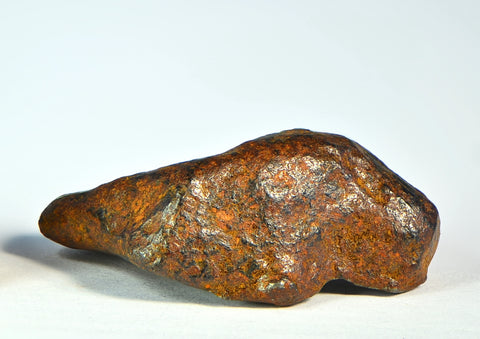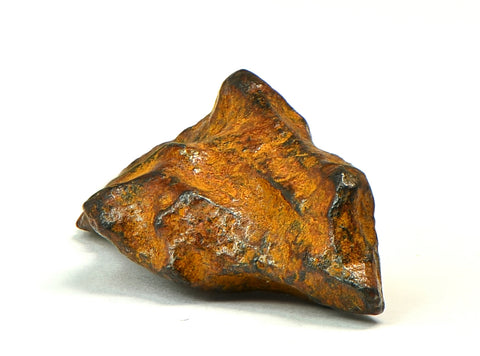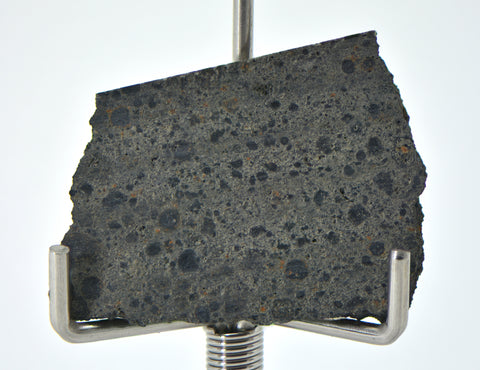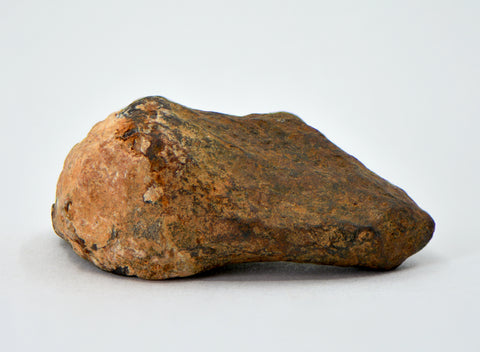1.85g AGUAS ZARCAS Meteorite I Carbonaceous Chondrite CM2

On Offer: 1.85g Aguas Zarcas Carbonaceous Chondrite meteorite from the April 23rd, 2019 fall in Costa Rica.
Type: CM2 Carbonaceous Chondrite
Description: Beautiful 1.85 gram Aguas Zarcas carbonaceous chondrite meteorite with beautiful crust. Classified as a CM2 carbonaceous chondrite. This CM2 carbonaceous chondrite from Costa Rica's recent fall on April 23 is arguably the most important meteorite fall since the Murchison fall of September 1969 in Australia, for which the CM meteorite subclass is named.
CM2: The "C" designates carbonaceous and the "M" indicates Murchison-like. The numeral "2" after the CM indicated the level and type of: "equilibration 3 - 7" or "aqueous alteration 1 - 2". For this meteorite the designation of 2 indicates it has been altered by water after its formation. Pretty amazing!
The Recovery Expedition: Aguas Zarcas was probably the most exciting and successful meteorite recovery expedition I have ever been involved in. I was fortunate to personally recover approximately 633 grams of this CM2 meteorite, and was able to purchase or trade for another ~ 3 kilograms of the meteorite. My team and I were also fortunate enough to recover some of the "Marina" hammer stone fragments that went through the Marina community center's green tin roof. It was an adventure that lead us deep into the Costa Rican rain forest, through vast tracks of farmland cut from jungle, up mountain roads muddy and impassable even by 4x4 on the worst days. Dashes into a bull filled field, risky crossings of raging rivers. Pleasant walks and breathtaking views. Amazing animals and wildlife everywhere you turn. It introduced us to the beauty of the local people, their generosity and hospitality. We came to recover a fall, and fell in love with it all. Aguas Zarcas, forever in our hearts.
What you get: 1.85 gram AGUAS ZARCAS Carbonaceous Chondrite beautiful Meteorite Specimen as shown, Membrane Storage/Display Box, & signed Certificate of Authenticity.
I offer a 100% no questions asked 30 day return policy.
SEE OFFICIAL METEORITICAL SOCIETY ENTRY BELOW
| Aguas Zarcas | |||||
|---|---|---|---|---|---|
| Basic information |
Name: Aguas Zarcas This is an OFFICIAL meteorite name. Abbreviation: There is no official abbreviation for this meteorite. Observed fall: Yes, confirmed fall Year fell: 2019 Country: Costa Rica Mass:  27 kg 27 kg |
||||
| Classification history: |
This is 1 of 504 approved meteorites classified as CM2. |
||||
| Comments: | Approved 30 May 2019 Revised 31 May 2019: corrected fall date |
||||
Writeup |
Writeup from MB 108:
Aguas Zarcas 10°23’29.03"N, 84°20’28.58"W Alajuela, Costa Rica Confirmed fall: 2019 Apr 23 Classification: Carbonaceous chondrite (CM2) History: (G.J. Soto; P. Madrigal, O. Lücke, Escuela Centroamericana de Geología, Universidad de Costa Rica; M. Farmer, Arizona) At 21:07 local time on 23 April 2019, a meteorite fall was reported in Aguas Zarcas, San Carlos county, Alajuela province, Costa Rica. The fireball traveled WNW to ESE and was caught on cameras of the National Seismological Network (RSN) at the summit of Poás and Turrialba volcanoes, and from the Volcanological and Seismological Observatory of Costa Rica (OVSICORI). Sightings were reported from Quepos (Central Pacific) in the south and north to La Palmera in San Carlos. The first piece recovered, 1152 g, crashed through a house at 10°23’29.03"N, 84°20’28.58"W. A dog house was hit by a 280 g piece at 10°24’9.35"N 84°21’51.26"W. The BRAMON (Brazilian Meteors Observation Network), UNESP (São Paulo State University) and USP (University of São Paulo) teams determined the atmospheric trajectory of the bolide from four security videos and dashcam cameras. The bolide had an entry angle of 73° relative to the ground, traveling 20.7 km in the 4-s analyzed interval, with an atmospheric velocity of 14 km/s. Analysis shows a projected elliptical strewn-field with major axis length of 6.3 and minor axis of 3.3 km. Hundreds of stones were recovered within the projected strewn-field. The bolide orbit was determined, with the follow preliminary elements: semi-major axis 2.7 AU, eccentricity 0.63, inclination 3.09°, pericenter longitude of 185.3° and ascending node 33.4°. Current total recovered mass is around 27 kg, of which ~11 kg was collected before rain fell over the fall site. Physical characteristics: (L. Garvie, ASU) Hundreds of fusion-crusted stones ranging from 0.1 to 1868 g. Stones under ~50 g are typically angular to blocky and lack regmaglypts. Also found were several plate-like, oriented stones. For example, one oriented plate is 13 cm wide and 1 cm thick. Many stones are oriented with a domed leading edge and well-developed roll-over lip along the rim of the trailing edge. Larger stones, especially those near 1 kg, show broad regmaglypts, some well developed. The fusion crust on several of the trailing edge surfaces is iridescent. Pre-rain material crushed in a few ml of water emits a powerful "Murchison-like" odor, though with a more prominent compost-like scent. Petrography: (L. Garvie, ASU) The interior of the stones is uniformly dark gray and studded with small light-colored speckles. Stones are brecciated and dominated by two lithologies: chondrule poor, constituting ~80 areal% of the broken surfaces examined (~2 kg of material), and chondrule rich. Chondrules constitute ~10 areal% of the chondrule-poor lithology and ~40 areal% in the chondrule-rich lithology. Some broken surfaces show clasts of the chondrule-rich lithology in the chondrule-poor type. Clasts with lower chondrule to matrix ratio also present; for example, one 3 g half stone shows <1 areal% chondrules. A probe mount of the dominant chondrule-poor lithology (sample area 1.5 × 2.2 cm) shows scattered small chondrules (mean 275 μm, n=40), with prominent fine-grained rims. Rare chondrules to 2 mm. Fe-Ni metal, which is Cr-bearing, was only found as rounded grains in one 100-μm type I chondrule. The section contains several Al-rich CAIs to 300 μm. The matrix is dominated by two components of roughly equal proportions: anhedral clumps (typically 50 microns) that are Fe and S rich (e.g., 37.5 wt% Fe and 5.8 wt% S, with microprobe total of 93%), surrounded by fine-grained material poorer in Fe and S (e.g., 12.8 wt% Fe, 13.9 wt% Mg, and 0.5 wt% S, with microprobe total of 80.0%). Powder XRD from five stones (one chondrule rich) shows patterns dominated by serpentine. In two stones, the serpentine 001 reflection sits on a broad peak centered at 0.843 nm. Reflections for tochilinite and calcite occur in all patterns. The intensities of olivine and pyroxene reflections were generally low, but most prominent in the chondrules-rich stone. Geochemistry: Oxygen isotopes (K. Ziegler, UNM): 7 pre-rain fragments analyzed by laser fluorination gave δ18O= 10.342, 10.807, 11.591, 12.314, 12.249, 12.669, 9.748; δ17O= 2.381, 2.932, 3.360, 3.843, 3.995, 3.959, 2.143; Δ17O=-3.080, -2.775, -2.759, -2.659, -2.472, -2.730, -3.004 (linearized, all per mil, TFL slope=0.528). Microprobe (L. Garvie, ASU): Fa0.4-41.0, n=10. Classification: Geochemistry and oxygen isotopic data consistent with CM2. |
||||
We Also Recommend











